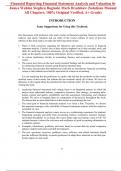Exam (elaborations)
Solutions Manual for Financial Reporting Financial Statement Analysis and Valuation 8th Edition By James Wahlen Stephen Baginski Mark Bradshaw (All Chapters, 100% Original Verified, A+ Grade)
- Course
- Institution
This Is Original 8th Edition of Solutions Manual From Original Author. All Other Files in the market are fake/old Edition. Other Sellers Have changed old Edition Number to new But solutions Manual is old Edition. Solutions Manual for Financial Reporting Financial Statement Analysis and Valuati...
[Show more]



